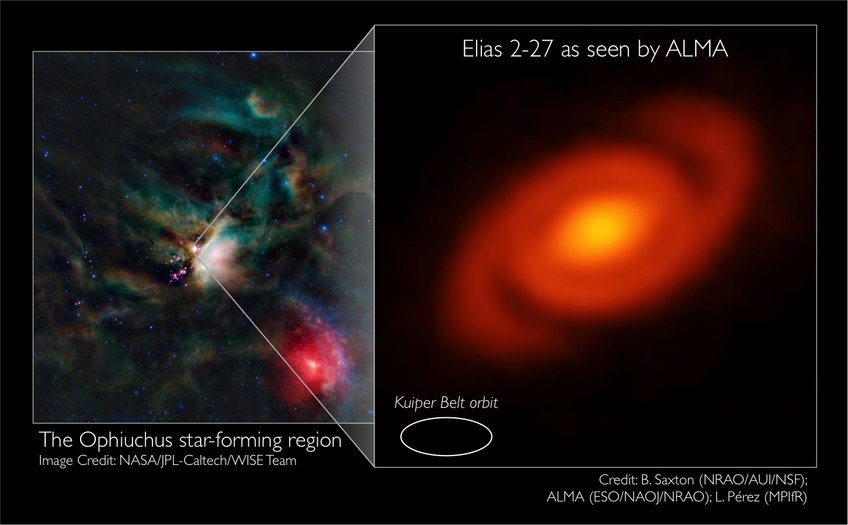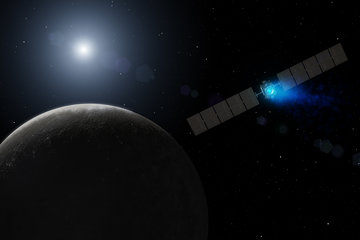Spirals assist in the birth of planets
Astronomers discover density waves in a protoplanetary disk around a star
A team of scientists headed by Laura Pérez from the Max Planck Institute for Radio Astronomy in Bonn has discovered a striking spiral-arm structure in the disc of gas and dust around the young star Elias 2-27. The structure is made up of the matter near the midplane of the disc - the region in which new planets can be born. This means: the spirals are either a result of the presence of young planets or they create the conditions under which new planets form in the first place.

Where stars are born: The photo on the left is an infrared image of the Rho-Ophiuchi region at a distance of around 450 light years. The image on the right shows the thermal dust emissions from the protoplanetary disc surrounding the young star Elias 2-27.
Planets are born in the interior of discs of gas and dust around newborn stars. This basic idea has a long history, but it is only recently that astronomers have been able to observe these discs directly. An early example is the discovery of the silhouettes of these discs in the 1990s with the Hubble space telescope. Astronomers succeeded in obtaining detailed images only very much later, however. For instance, it was 2014 when ALMA helped them detect gaps in protoplanetary discs.
And a group of astronomers headed by the Humboldt Research Fellow Laura Pérez from the Max Planck Institute for Radio Astronomy used this radio telescope – the Atacama Large Millimeter Array in the Chilean Andes, whose 66 dishes make it the biggest in the world – to observe the young star Elias 2-27, which is in the Snake-Holder (Ophiuchus) constellation around 450 light years from Earth. The team discovered the spiral structure mentioned – without which the planets could possibly not form at all.
The reason for this lies in the birthing process: within a disc of matter, the dust particles collide and clump together. Over time, this creates larger and larger objects. Problems arise as soon as the objects grow to more than a few metres. The surrounding gas then causes so much drag as the objects move on their orbit around the star that they migrate inwards on timescales of 1000 years or less, and fall into the central star.
The birthing process is thus interrupted, because a much longer time is needed for such bodies to collect sufficient mass by successive collisions to grow to the size of planets, at which point their size then means that gas drag has relatively little impact. So how is it that larger objects can form at all? Several possible mechanisms have been suggested that would allow the primordial rocks to grow and ultimately reach the size where they mere with the aid of gravity to form full-size planets.
In regions of higher density as occur along the density waves which have just been observed, the planet formation could progress much more rapidly, due to the increased gravitational force in the region concerned as well as the higher probability of collisions.
“The structure we have observed with Elias 2-27 is the first direct indication of spiral density waves in a protoplanetary disc,” says Laura Pérez. “It shows that instabilities can form within the disc, leading to sub-regions with much higher density and thus the formation of further planets.” These instabilities occur not only on the dimensions of planet formation: probably the best-known example is density waves in spiral galaxies that give rise to their distinctive spiral arms.

Conversely, planets which have already formed in the disc can trigger spiral density waves while they orbit the central star. To differentiate between these two roles – spiral arms as the trigger for planet formation on the one hand, or being formed themselves by young planets on the other – a deeper understanding is required, and observations such as the ALMA image just published will make their contribution here.
“After years of being able to measure only the integrated thermal radiation around young stars, we now see them in all their beauty and diversity, in the meantime with a spiral structure as well. This helps us to gain a better understanding of how planets form,” says Thomas Henning, Director at the Max Planck Institute for Astronomy in Heidelberg, who was also involved in the most recent observations.
“Over the past decades, astronomers have found a considerable variety of exoplanets. We can only explain this variety when we understand the early phases of planet formation – and the impressively detailed ALMA images make an important contribution here,” says Hendrik Linz, also a scientist at the Max Planck Institute in Heidelberg.
The two sweeping spiral arms around Elias 2-27 extend to more than ten billion kilometres from the young star – further into space than the Kuiper belt in our Solar System. “The presence of spiral density waves at these extreme distances from the star could explain the existence of exoplanets, which orbit their central stars at a similarly large separation,” says Pérez. The conventional models say that these planets should not be able to form locally in the first place.
The young star Elias 2-27 is part of a much larger star formation region bearing the designation Rho Ophiuchi in the Snake-Holder constellation. Elias 2-27 formed only around one million years ago – very recently compared to the age of our Sun, which goes back around 4.6 billion years. Researchers already knew that this star is surrounded by a disc; according to previous observations with a resolution of between 0.6 and 1.1 arc seconds, it could just as well have been an unstructured disc with cylindrical symmetry, however.
The new ALMA observations with a very high resolution of 0.24 arc seconds show radiation with a wavelength of 1.3 millimetres. This is caused by the presence of dust particles that make up between one and ten percent of the total mass of the disc. Using this radiation, the astronomers were able to track the spiral pattern mentioned over a range spanning from approximately 100 astronomical units (i.e. 100 times the average distance between the Earth and the Sun) to 300 astronomical units from the central star.
As mentioned above, the spiral structure could be caused by a planet which already exists within the disc. ALMA has indeed discovered a narrow band with much less dust, but it is not large enough to accommodate a planet which in turn would be large enough to generate the spiral pattern observed.
On the other hand, the gravity of the disc itself can also cause instabilities which can produce these spiral patterns. Given the total mass of the disc and the form and symmetry of the spiral pattern, the authors also consider this possibility to be highly likely.
“ALMA observations of this type are becoming increasingly frequent and should provide us with more and more images of inhomogeneous sub-structures in protoplanetary discs,” says Karl Menten, Director at the Max Planck Institute for Radio Astronomy and co-author of the article in the Science journal. “We should thus increasingly be able to describe the properties of these structures in more detail and clarify the role they play in planet formation.”
NJ / MP / HOR













